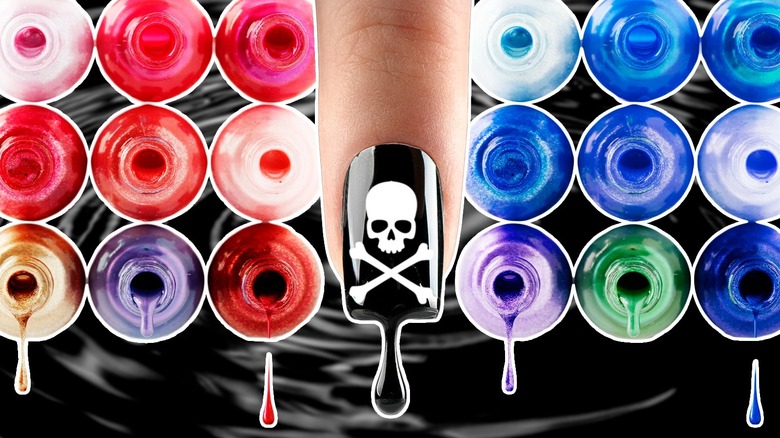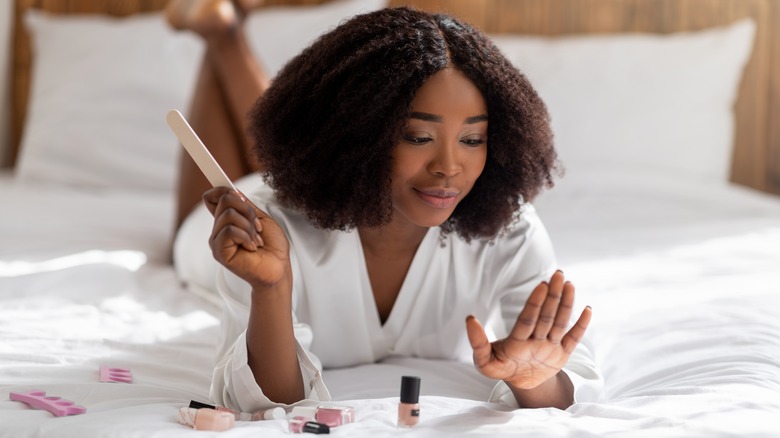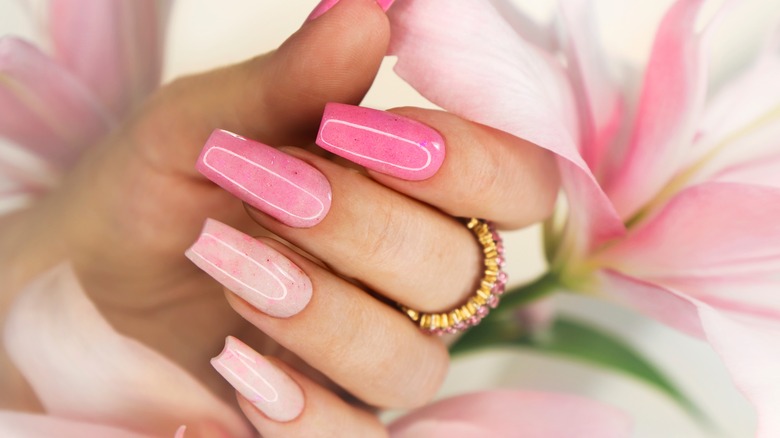Nail Polish Ingredients To Avoid At All Costs
Would you agree that getting your nails done by an unverified expert is one of the worst things you can do to your hands? First, there's the danger of submerging your nails in water for too long, which can weaken them. This is why a dry manicure might be better for your nails. However, that's not the only potential danger. An inexperienced nail technician could use a nail polish brand that contains toxic ingredients, such as formaldehyde.
Formaldehyde is a colorless, strong-smelling gas sometimes used as a hardening or preservative agent in nail polishes. But despite its use, it's a known carcinogen, per the American Cancer Society. Even worse, there's sufficient evidence that formaldehyde causes more than one type of cancer, and the toxin can cause allergic reactions in some people, with symptoms like coughing, wheezing, and breathlessness (via DermNet). Formaldehyde can also trigger asthma attacks and irritate the eyes. Sadly, not all nail polish brands have done the right thing in recalling products formulated using this chemical, and some products still contain it. For instance, the environmental organization Women's Voices for the Earth notes that nail brands like Regal and Beyond still include formaldehyde in at least some of their polishes.
Meanwhile, other brands might present formaldehyde under names like "methylene glycol" and "formalin," according to the U.S. Food & Drug Administration, but they aren't the only nail polish ingredients to look out for, either.
Dibutyl Phthalate
Let's talk about dibutyl phthalate (DBP), a clear liquid with a faint odor that is commonly used as a plasticizer in nail polish. Its purpose is to prevent cracking or chipping of the polish and provide a smooth, glossy finish. However, studies have linked DBP to reproductive abnormalities. For example, a 2020 study published in the International Journal of Occupational Medicine and Environmental Health gave an overview of the current evidence on this chemical's toxicity, revealing that it can "disrupt the hormonal balance" in the body. Furthermore, its "weak estrogenic effect" can disrupt the natural hormonal balance in women, which could potentially cause greater health issues.
One intriguing aspect of this toxin is that lower doses of DBP cause more harm than higher doses. More surprising is that the complications don't end there. Because of the danger of this toxin, many nail companies use triphenyl phosphate (TPHP) as a "better alternative." However, reading up on hacks to make your manicure last longer is better than using products with TPHP, as it's actually worse than DBP. A 2015 study by the Environmental Working Group discovered that applying nail polish containing TPHP caused an increase in the amount of the DPHP toxin in the body by "nearly sevenfold."
Toluene
Next up is toluene, a popular chemical used as a solvent in many nail polish brands. But, as you may have already guessed, it's far from safe. Toluene is a colorless liquid derived from petroleum with a strong, lingering odor, and it dissolves resins, pigments, and plasticizers in nail polish formulations. Unfortunately, exposure to toluene can lead to respiratory irritation and dizziness (via the CDC).
But worst of all, a 1997 study published in the Journal of Environmental Research highlighted that toluene exposure can cause the central nervous system to "dysfunction." This is bad news, as this system includes the brain and spinal cord, which influence various body systems. A central nervous system malfunction can complicate bodily functions, lead to physical disabilities, and result in cognitive and behavioral changes.
The good news is that you can check if your brand contains toxins by checking the ingredient list. Bonus tip? You can use Women's Voices for the Earth's list of nail products that contain less-than-ideal chemicals. Then, in the future, you can shop for clean nail polish brands, including Essie's and Londontown. Essie's, in particular, was worn by the late Queen Elizabeth II for over 30 years, and that's a pretty big stamp of approval. What's more, both brands have products ranging from $10 to $20, so you're sure to find something safe and budget-friendly.


